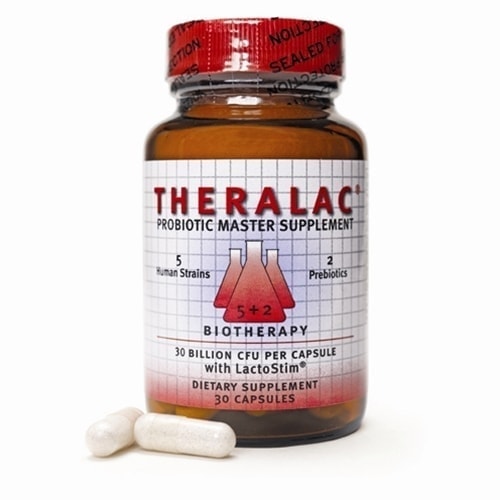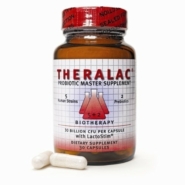Theralac – 30 capsules
CAD$119.14 Import fees, brokerage, duties incl.
What are probiotics?
Probiotics are beneficial bacteria that are able to colonize the intestinal tract and help promote healthy structure and function; Lactobacillus acidophilus is an example of a well known probiotic.
Theralac® is an ultra potent probiotic with a patented acid proof delivery system. Formulated at over 40 billion CFU our guarantee is 30 billion CFU at expiration. One bottle will last 10 weeks on our standard dose program.
Is Theralac the same as Acidophilus?
Yes, but much more…Theralac capsules contain 10 billion CFU of Lactobacillus acidophilus (LA-1 strain), a well documented, bile tolerant strain with a long history of use in human dietary supplements. This makes Theralac five times stronger in “Acidophilus” than most probiotic products. Additionally, Theralac contains 40 billion CFU of four symbiotic probiotics that go beyond the capability of Acidophilus: These are select strains of lactobacillus and Bifidobacterium species that are backed by scientific studies. ONLY THERALAC CONTAINS THIS BLEND OF RESEARCH PROVEN PROBIOTIC STRAINS.
What is a CFU and why do I need so many?
CFU stands for Colony Forming Unit . It’s the number of bacterial colonies that form on a Petri dish and indicates a product’s viability or strength. Your intestinal tract contains over 1OO trillion microorganisms from about 1,000 different species, mostly bacteria. Only high potency probiotic products (those containing 10 billion CFU/capsule or more) can reliably re-establish the probiotic population within this huge number.
Is a probiotic deficiency common?
Quite common! Many lifestyle factors favor undesirable microorganisms over probiotics in your intestinal tract: stress, poor diet (sugar and fat), alcohol, prescription drugs, travel, frequent colds or infections, and aging are the big ones. It’s hard for a modern person not to have a probiotic deficiency to some degree.
What are the symptoms of a probiotic deficiency?
They vary from person to person but may include one or more of the following: Constipation or diarrhea, indigestion, incomplete digestion, heartburn, excess gas and bloating, lactose intolerance, weak immune response (frequent colds and infections), fatigue, low energy, muscle weakness, and food allergies. Obviously, you cannot be at peak health if you have a probiotic deficiency!
Do I need to take Theralac every day to correct a probiotic deficiency?
No. Theralac’s advanced, high potency formulation allows you to take two capsules per week once your intestinal tract’s microflora has been balanced (this occurs for most people after taking Theralac daily for two weeks). The ability to take a probiotic twice a week provides convenience and cost savings. On the maintenance dose a bottle of Theralac can last up to 4 months and cost less than $3.00 a week!
NOTE: Taking Theralac daily for two weeks provides 560 billion CFU to your intestinal tract, a very effective dose by probiotic standards. Once this dose colonizes the intestinal tract it can be maintained by taking two capsules (80 billion CFU) per week.
What is a prebiotic?
A food grade substance that benefits probiotic bacteria by some specific mechanism.
How do Theralac’s prebiotics work?
Theralac contains two prebiotics that are effective at low dosages; LactoStim (patented) and Sodium Alginate. LactoStim is a food grade emulsifier that stimulates the growth and reproduction of Theralac’s probiotic bacteria (patented). Unlike FOS and other prebiotics, Lactostim works in mg quantities!
Will foods rich in FOS also benefit Theralac’s probiotics?
Yes. FOS, or fructooligosaccharides, are prebiotics that you can get by eating certain foods, and are required in larger quantities compared LactoStim. FOS can cause gas in some individuals when taken as an isolated prebiotic. When taken in food, the unidentified nutrient factors help reduce the gas issue. For the best prebiotic, take TruFiber see www.trufiber.net
The following foods contain a unique source of soluble fiber (FOS) that stimulates probiotic bacteria. Eat some when you take Theralac!
| Food | FOS |
| Garlic | 1.0% |
| Honey | 1.0% |
| Rye Bread | 0.6% |
| Brown Sugar | 0.4% |
| Asparagus | 0.4% |
| Bananas | 0.3% |
| Onions | 0.3% |
| Barley | 0.2% |
| Tomatoes | 0.2% |
So, how does Theralac work in my intestinal tract?
The probiotic bacteria in Theralac attach to the soft lining (wall) of your intestinal tract and help keep it healthy. The lactobacillus (“lacto”) strains are most active in the small intestine while the Bifidobacterium (“Bifido”) strains work best in the large intestine (colon). A healthy intestinal wall encourages optimum absorption of nutrients, including vitamins and minerals, and supports healthy digestion and elimination. Theralac also benefits your immune system…
How does Theralac benefit my immune system?
Theralac’s five probiotic strains work together (in symbiosis) to stimulate the mucosal immune system on the intestinal surface which then sends activation signals to the body’s systemic immune system. Because Theralac’s strains are beneficial this action is gentle and modulated. The immune system is put on “yellow alert” so to speak, ready to act quickly when pathogenic microorganisms appear.
What is the most common effect I will experience when taking Theralac?
Improved elimination and regularity: Softer and more predictable bowel movements followed by more energy and intestinal comfort.
Is it best to take Theralac with food or on an empty stomach?
Either way works well due to Theralac’s ACID PROOF formulation. Take Theralac with water, fruit juice or milk.
How does Theralac’s acid-proof formula compare to enteric coated probiotics?
Much better and safer! Most enteric coated probiotics are treated with a polymer of acrylic acid, a synthetic chemical. The sodium alginate used to acid-proof Theralac capsules is a natural carbohydrate found in kelp (patented). NOTE: Studies show that > 99% of unprotected probiotics are killed when exposed to stomach acid for 1 hour, a typical time spent in the stomach.
Can I take Theralac when taking antibiotics?
Yes. Take the antibiotic at the prescribed time followed by Theralac two-three hours later. Continue taking Theralac daily for at least two weeks after finishing the antibiotics.
How many Theralac capsules should I take when traveling?
Take at least one per day. When traveling to developing countries take two per day, one in the morning and one in the evening. Intestinal problems are easier to prevent than treat so start taking Theralac daily one week before you leave.
It says on the Theralac bottle, “Best if Refrigerated”; how stable is Theralac at room temperature when traveling?
Theralac can be held at room temperature (65°-75° F) for up to 30 days without loss in viability. Keep bottle tightly closed and out of direct sunlight.
Can Theralac reduce lactose intolerance?
Lactose intolerance results from a lack of the enzyme lactase in the small intestine. All five of Theralac’s probiotic strains produce lactase and may reduce the severity of lactose intolerance.
Can Theralac improve vitamin and mineral absorption?
Vitamins and minerals are absorbed in the small intestine. The health and integrity of the intestinal soft lining (wall or mucosa) affects the absorption of all nutrients including vitamins and minerals. Theralac may help improve vitamin and mineral absorption by maintaining a healthy soft lining. In addition, mineral absorption, especially calcium and magnesium, is improved by a slightly acid pH at the mucosal surface. The probiotic strains in Theralac produce lactic and acetic acids which lower pH (acidify), if this occurs on the surface of the soft lining it may enhance Ca and Mg absorption.
Can I overdose on Theralac?
What would be the effect? Probiotic bacteria, including those in Theralac, have been used in dosages of one trillion CFU/day or more without harmful effects. At very high dosages probiotics may cause diarrhea in some people which can be eliminated by reducing the dose. Sometimes when high potency probiotics are used for the first time a short period of discomfort results while the intestinal tract’s microflora is being rebalanced. This is called the Herxheimer Reaction.
Can you explain the Herxheimer Reaction in more detail?
The Herxheimer Reaction is a period if discomfort that sometimes results when harmful microorganisms are rapidly killed off in the intestinal tract and their toxic byproducts accumulate prior to elimination. When the intestinal tract is severely out of balance (has low numbers of probiotic bacteria) and one takes a high potency probiotic, it may cause a sudden die off of harmful bacteria (or yeast) followed by detoxification symptoms such as bloating, cramping, gas or headaches. Usually these symptoms subside in a short time as the probiotics gain control and the harmful microorganisms are eliminated. If this happens, stay the course with the probiotic or lessen the dose slightly. If severe or persistent symptoms occur see your doctor.
Why are Theralac capsules made of cellulose (Vegicaps) instead of gelatin?
Gelatin is derived from beef byproducts and is not acceptable to vegetarians. Some non-vegetarians object to beef byproducts for other reasons. Vegicaps are made from materials of plant origin. Theralac does not contain any: milk, yeast, eggs, corn, soy, gluten, wheat, casein, nuts, seafood or beef products








